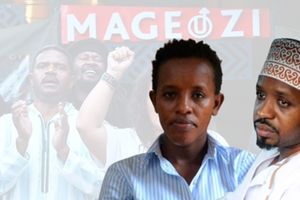
President William Ruto (right) with President Samia Suluhu of Tanzania during a meeting of East African Community Heads of State in Arusha 30 November 30, 2024
The ongoing war of words between Kenya and Tanzania - sparked by the deportation of prominent individuals, including Martha Karua and Justice Willy Mutunga, and the reported torture of activist Boniface Mwangi - feels less like diplomacy and more like a reality TV reunion special.
It has rekindled memories of the 1970s, when a bitter bromance breakup between Presidents Jomo Kenyatta and Julius Nyerere led to a dramatic border closure and the spectacular collapse of the original East African Community (EAC). Today’s tensions echo that past - history repeating itself, not as tragedy, but as farce, complete with social media spats and parliamentary roast sessions.
Back in the day, Tanzania sneered at Kenya’s cutthroat capitalism as a “man-eat-man society,” while Kenya clapped back, branding Tanzania’s socialism a “man-eat-nothing society.” It was like a political rap battle, but with fewer rhymes and more resentment. Fast forward to now: Tanzanian MPs recently went full retro, publicly denouncing Kenya and throwing shade like it’s 1977. Instead of promoting trade, the two countries have opted to trade insults and with Tanzania throwing tantrums over Kenya political activists’ entry into the country to observe the trial of opposition politician, Tundu Lissu.
The challenge remains: can these neighbours learn from past follies, or are they doomed to keep replaying the same old script, rebranded but unmistakably familiar?
After the bitter divorce of the original EAC, the three partner states found themselves squabbling over the assets like siblings fighting over land and bank accounts. The International Monetary Fund sent Dr Victor Umbricht, a Swiss diplomat to resolve the matter without triggering war.
Umbricht was supposed to finish the job in a year, but it ended up taking four. It turns out that assets and records vanished as agents engaged in more backroom deals than a shady broker.
In the end, the whole mess was less a peaceful parting of ways and more a messy, drawn-out custody battle. And just like any messy breakup, it left everyone wondering: why couldn’t we just split the assets and move on?
One can deduce that the bitterness was only postponed – and handed to another generation of keyboard warriors. Watching Tanzanian parliamentarians lambast Kenya reminded me that these were the seeds of discord that had been sown as early as 1971. They are seeds of suspicion and of big bully syndrome.
In 1976, Charles Njonjo was reluctantly drafted into a high-powered Kenyan delegation headed to a regional meeting meant to reaffirm Kenya’s commitment to the EAC - a mission drenched in irony. Sending Njonjo to save the Community was like sending a divorce lawyer to fix a broken marriage.
The delegation, led by then-Finance Minister Mwai Kibaki, included East African Community Affairs Minister Robert Ouko and Power and Communications Minister Isaac Omolo-Okero. They arrived armed with talking points and carefully rehearsed optimism - everyone, that is, except Njonjo, whose trademark Savile Row suits couldn’t quite hide the fact that he’d already mentally written the EAC’s obituary.
During a brief coffee break - where delegates nervously sipped tea and stirred regional anxieties - Njonjo casually cornered Dr Ouko, delivering what may have been the most brutally honest eulogy for the EAC ever uttered before its actual death.
“Why are you fighting so hard to maintain this thing?” he asked, voice flat, eyes unblinking.
“Which thing?” Ouko replied, startled.
“This East African Community of yours,” Njonjo said, as though discussing a broken typewriter. “You are an able man of experience. You’ll land a big job in Kenya. Why are you bothering with this thing?”
Ouko, ever the Pan-African idealist, launched into a passionate defense of the EAC - solidarity, integration, unity - but Njonjo waved him off like a waiter offering decaf.
“Forget it,” he said, almost bored. “It will break up.”

President William Ruto and his Tanzanian counterpart Samia Suluhu during The Mission 300 Africa Energy Summit, in Dar es Salaam, Tanzania.
And so, it did. Within months, the EAC - once the proud flagbearer of regional ambition - collapsed under the familiar weight of mutual suspicion, political ego, and nationalist one-upmanship.
When the collapse became official, Njonjo didn’t hold back. In Parliament, he declared with unfiltered glee:
“I was so overjoyed at the break-up of the Community that I drank five glasses of champagne in celebration.”
It was not so much a toast to the future as it was the ceremonial burial of an idea he had never invited to the table in the first place.
At the heart of the EAC’s unraveling was this fundamental ideological divergence. Following the Arusha Declaration of 1967, Tanzania had chosen ujamaa as its guiding principle, a model that emphasised collective agriculture, rural self-reliance, and state control of key sectors. Uganda, under Obote, pursued his own leftist path through the Common Man’s Charter, which advocated a mixed economy grounded in social justice and state-led development.
Kenya, meanwhile, had taken a markedly different course. While it had issued Sessional Paper No. 10 of 1965, titled “African Socialism and its Application to Planning in Kenya,” its implementation was anything but socialist in practice. The paper paid lip service to egalitarian ideals, but the reality on the ground was a determined push for capitalism, foreign investment, and elite-driven economic growth. Kenyatta, wary of both Nyerere’s socialism and Obote’s populism, anchored Kenya’s development firmly in the logic of the free market.
Thus, the East African Community, conceived in hope, perished in hubris.
Tanzanian officials, already wary, were incensed further by the ease with which Kenya established Kenya Airways in the wake of the collapse, while Tanzania was left grounded - bereft of a national carrier. Kenya also laid claim to overseas assets of the defunct airline, including valuable VC-10 engines, a Boeing 707 engine located in Addis Ababa, and an additional spare engine in Switzerland.
Ultimately, a formula was devised to dissolve the original East African Community (EAC): Kenya would receive 42.7 per cent of the assets, Tanzania 34.3 per cent, and Uganda 23 per cent. In May 1984, the three nations signed the East African Community Mediation Agreement Act, bringing an official end - at least on paper - to nearly a decade of acrimony, economic rivalry, and political suspicion. Yet the agreement, while resolving the immediate issue of asset division, did little to dispel the deep-seated mistrust between Kenya and Tanzania.

President William Ruto with Tanzanian President Samia Suluhu Hassan in Dar es Salaam on October 10, 2022.
Though the EAC was revived in 2000 with renewed optimism and an expanded mandate, the old suspicions have proven remarkably resilient. Beneath the surface of summit communiques and integration protocols lies a complex web of historical grievances, competitive nationalism, and diverging political cultures.
Periodic diplomatic spats - such as trade restrictions, accusations of espionage, or the recent controversy involving the deportation of high-profile Kenyan figures and the mistreatment of activists - are symptoms of unresolved tensions that trace back to the collapse of the first EAC and the fraught negotiations that followed.
It seems that the ideological clash once framed as Man-Eat-Man versus Man-Eat-Nothing has returned - updated, but no less visceral.
John Kamau is a PhD candidate in History, University of Toronto, Canada. Email: [email protected]; X: @johnkamau1









